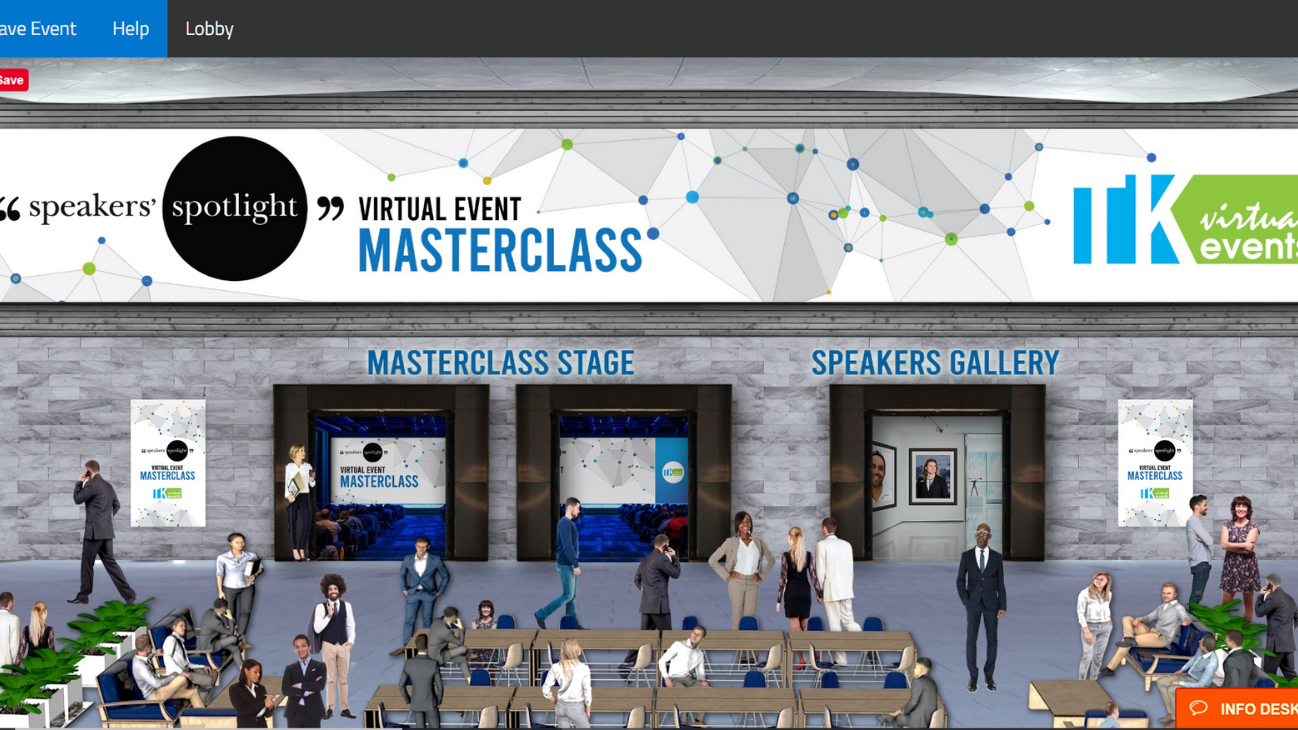What does the future of the events industry look like? While COVID-19 has disrupted our traditional way of connecting — face-to-face time — our need to connect is even stronger. Events play an important role in this, and thankfully today’s technology can help us continue to make an impact, virtually.
Last week, we hosted a Masterclass on Virtual Conferences and Events featuring industry experts Trish Knox and Josh Shepherd from TK Virtual Events. They have spearheaded the transition from in-person to virtual events, and shared advice to help our community of event professionals do the same.
Going Virtual
The beauty of virtual events is that you have more flexibility and freedom to create an event that best serves the needs of your attendees, instead of being pigeon-holed by the restrictions of a venue. Plus, event suppliers are in innovation mode right now— actively seeking digital solutions for their clients. Now more than ever, anything is possible!
What’s important to consider however, is that online events require a different way of thinking. When planning, we need to account for how people behave and interact online, plus how to best-use technology available to engage and immerse attendees in a virtual experience.
Here’s a few key tips that Trish and Josh shared with us:
1) Invest in Production Value
When it comes to virtual events, Trish said, it’s still important that we ask ourselves how we can elevate our event. Write down your wishlist of what you’d like to see and then find the virtual platforms that best meet that wishlist. Video-conferencing software is great for breakout sessions, webinars, etc., but when it comes to “main stage” events, that’s when you still want to treat it like an in-person event — invest in the production to create an experience for your attendees.
You want to hire the professionals. Having an AV crew as technical support is immensely helpful especially when working with new technology and live streams. It’s this type of production level that can re-create the magic of an in-person event online.
Working with an AV crew will be especially important as our industry continues to evolve along with COVID-19. Trish believes in the future events will take on more of a hybrid production. We may not be able to host an audience, she said, but we could possibly have speakers actually present on a stage with a live stream or record it for a later date.
2) Content is Key
Content has always been an important aspect of any event, but when it comes to online events, it is the key selling point. We no longer can create the same atmosphere or buzz as an in-person event, so we have to rely on the content — it’s the reason why people are going to register and it’s the reason why they’re actually going to log in.
Invest in your speakers and your programming just as much you would for your in-person event and equip them with the tips to help them best succeed in an online environment. For example, tell them to mute the audio and video functions for attendees on the video-conferencing platform — it’ll save everyone a lot of headaches!
When it comes to your sessions, keep them to a one-hour time limit, and build in interactivity — leave time for Q&As. Have a 30-45-minute keynote plus a 15-30-minute moderated discussion. Attendees will fire questions at the speaker throughout the presentations using the built-in chat functions, so leaving time at the end to answer these questions will keep attendees “in their seats” and give them that sense of connection with a speaker.
Secondly, mix up the format of your sessions. Popular video-conferencing platforms, such as Zoom, Webex, GoToMeeting, etc., provide us with the ability to still host panel discussions with multiple speakers, intimate fireside chats between company leaders and expert speakers, as well as the keynote speeches and webinar experiences.
Engaging content will sell your event, presenting that content in diverse, engaging formats, will keep online attendees engaged.
3) Re-Imagine Your Event Schedule
Our in-person events could be three-day affairs, packed with 8+ hours of programming each day. We can’t expect people to sit at their computers for eight hours. This means, you need to re-imagine your agenda, Trish said, and adjust it to fit to your attendees’ online habits.
Assume that you have 2-3 hours maximum of their attention per day. This means you need to break-up those full days of programming into multiple days that could even occur over multiple weeks. They need to be digestible chunks of content for an online audience, including built-in breaks.
Also, allow your attendees to build their own agenda through an online registration platform. Making registration as “official” as possible, where they not only sign-up for an event but actively engage in the schedule of that event, will encourage your attendees to actually show up on the day far more than just an emailed invitation with a clickable link.
Unfortunately, the no-show rate is higher for an online event, so taking pre-emptive steps to make the experience more formal, while also scheduling your programming to take into account the habits and need of remote attendees, will create more excitement and commitment to attend.
4) Create points of Human Connection
A huge perk of events is the networking opportunities they present — a time for us to connect with our peers and learn from each other. This still needs to be a component of a virtual event, but we have to be a bit more imaginative and proactive as to how we create these opportunities.
Video-conferencing platforms in general have built-in chat functions to encourage Q&As and audience interaction. Beyond this, additional online platforms can be used to create new kinds of social activities as well as re-create existing social activities. For example, there are platforms that can provide a virtual trade show exhibition experience. Events professionals can offer exhibitors and sponsors with “booth space” that they can graphically customize, along with the ability to set up one-on-one meetings that can take place in virtual meeting spaces.
To encourage peer-to-peer interaction, online attendee directories can allow people to browse who else is “at” the event and encourage messaging and one-to-one meetings. Social walls are also excellent ways for people to engage with each at the event, offering an opportunity to share real-time thoughts and reactions to the event.
Lastly, online game functions are available, including trivia hours or virtual scavenger hunts, etc. We may not be able to physically be with each other in a room, but online events offer a variety of options to connect for those interested.
5) Revel in the Available Data and Analytics
Gathering intel into the behaviour of your attendees at an in-person event is limited. This is where online events shine! Through using online platforms, not only can you track where attendees go at your virtual event, but how long they stayed. Finally we can get a reliable engagement rate and gather real-time data to show the impact an event has on people.
In addition, you can have the ability to poll attendees to get instant feedback. It can make reporting a far easier process and provide more substantial data to guide future event planning.
Video-Conferencing and Virtual Conference Platforms
Video-conferencing platforms allow us to re-create events virtually by connecting speakers with an audience remotely. High-quality video and audio, screen sharing, chat, and moderated Q&A are all regular features of these online platforms.
Some of the most popular platforms that our clients — and our company — use to host virtual events and conferences include:
- Zoom
- GoToMeeting
- Cisco Webex Meetings
- Join.me
In addition, online platforms have been created to go beyond the typical “webinar” and actually re-create the aesthetic of an in-person conference. Often these platforms provide event planners to create an online venue for their virtual attendees to gather with options to customize graphics to capture themes, offer branding opportunities to event partners, trade show functions, networking opportunities, advertising space, etc.
It’s through these platforms you also have the option to create more programming opportunities within your event schedule, such as a main stage and multiple breakout sessions or space for smaller events such as executive meetings.
Take a look through our photo album below of some of the incredible graphics that TK Virtual Events created for our Masterclass. We had a branded “venue” to welcome attendees, a main stage for the main event and instead of a trade show, we opted for a gallery to showcase some of our high-profile and most popular virtual speakers.
[inline-slider]
TK Virtual Events has also created platforms to host online galas, convocations, fundraisers, etc., adjusting the structure of the online venue to capture more of the up-scale and social aspects of these kind of events.
We had a great time hosting the Masterclass last week along with James Cunningham, emcee extraordinaire, who kept us to time and added some laughter along the way.
Click here to learn more about virtual presentations, and contact us to request a copy of this Masterclass or to learn more about TK Virtual Event’s online platform.




